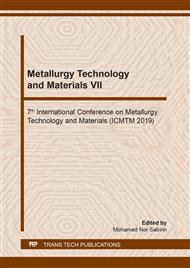p.121
p.128
p.135
p.141
p.149
p.155
p.161
p.167
p.175
Study on the Interface of Acetylene Silazane (SZ) Modified QF/PSA Composites
Abstract:
Due to the excellent thermo-stability, ablation resistance and superior dielectric properties, poly-silicon-containing arylacetylene resin (PSA) shows a promising application in aerospace and spaceflight industries as a composite matrix with quartz fiber (QF). However, the non-polar nature of PSA hamper the interfacial interaction with the QF resulting in a relatively weak mechanical strength for the whole QF/PSA composites. This can be alleviated by incorporating a coupling agent between QF and PSA to reinforce their interaction. Here, new coupling agents, three ethynyl silazane derivatives, were synthesized to improve QF/PSA composite mechanical properties and named as bis (3-ethynylaniline)-diphenylsilane (SZPP), bis (3-ethynylaniline)-methylphenylsilane (SZMP) and bis (3-ethynylaniline)-phenylvinylsilane (SZPV). For SZPP, about 3.0 wt% addition of this coupling agent increased the interlaminar shear strength and flexural strength of QF/PSA composite by 21.2% and 18.4%, respectively, compared with the untreated composite. Meanwhile, among the three coupling agents, SZPV showed the best improvement in enhancing the interlaminar shear strength and flexural strength of QF/PSA composites, which reached 34.1% and 41.7%, respectively.
Info:
Periodical:
Pages:
149-154
Citation:
Online since:
October 2019
Authors:
Price:
Сopyright:
© 2019 Trans Tech Publications Ltd. All Rights Reserved
Share:
Citation:


